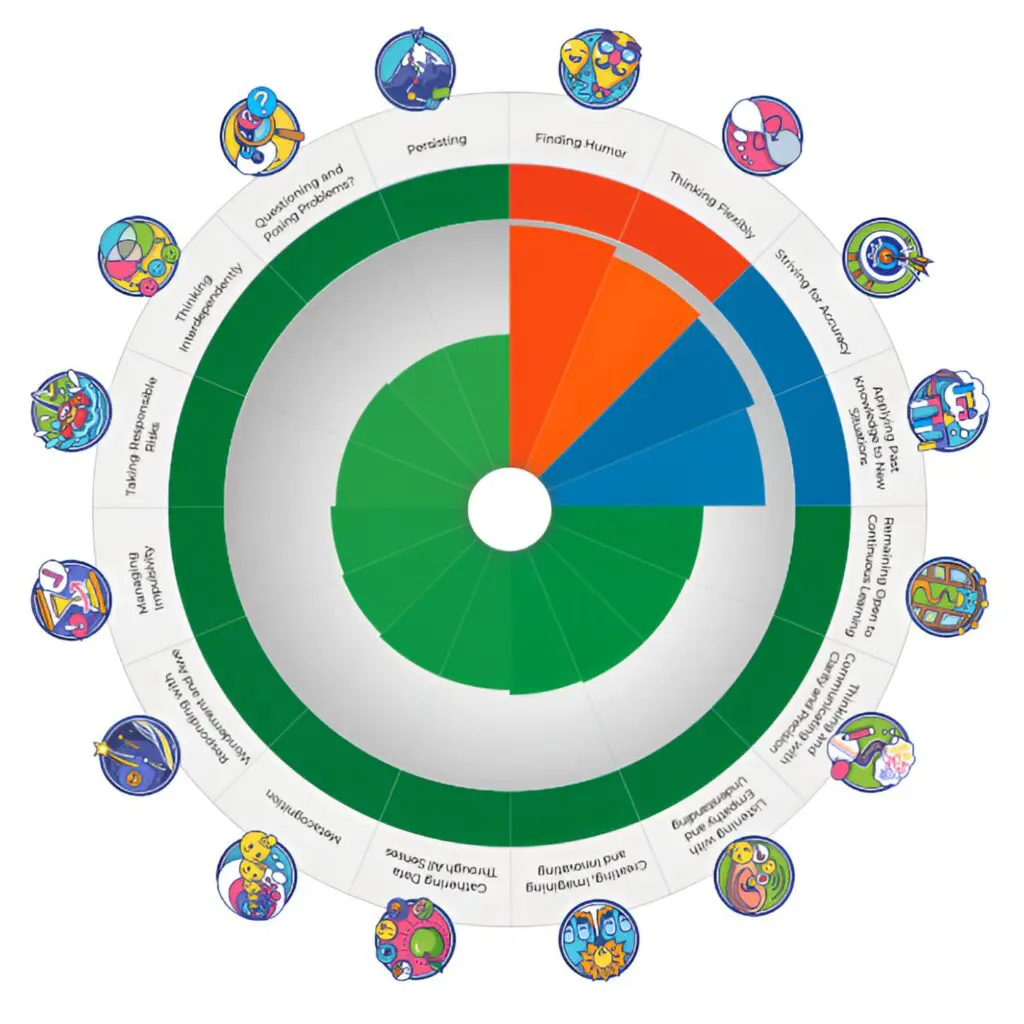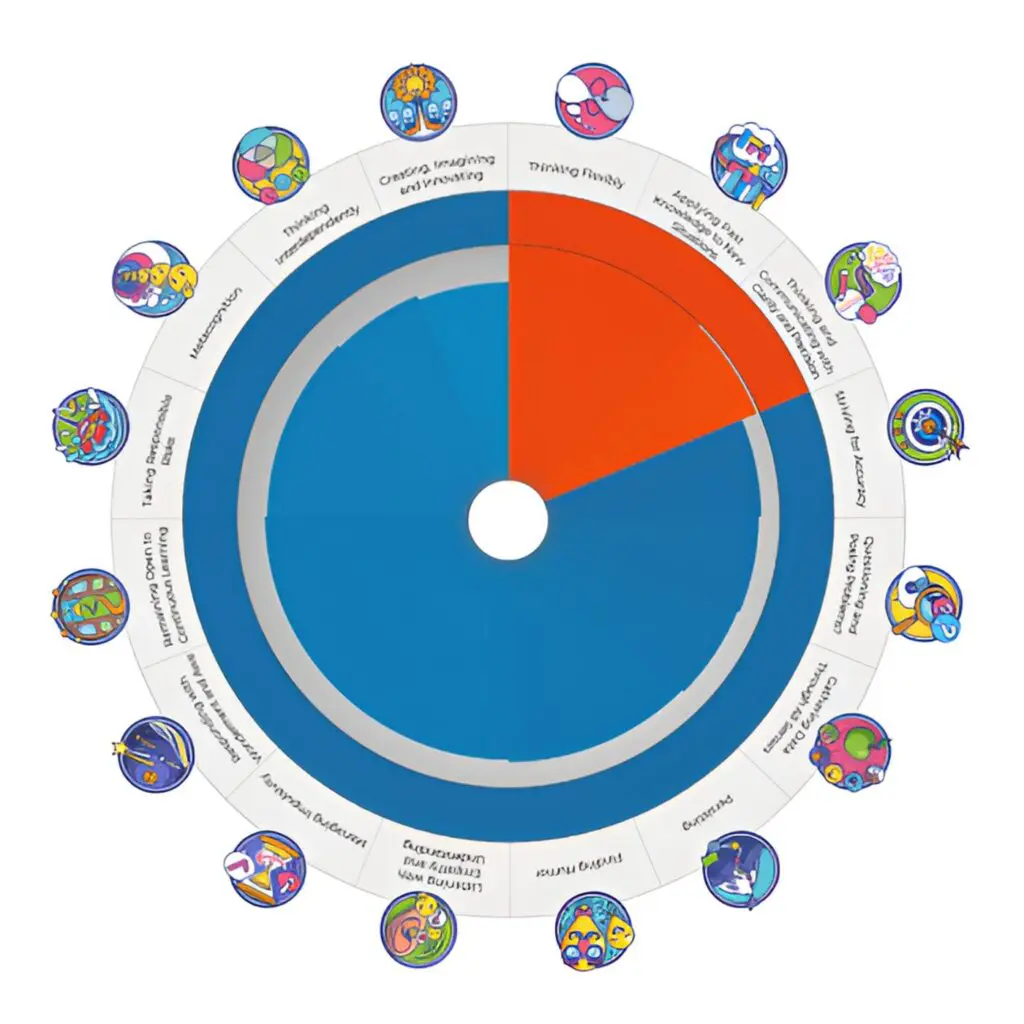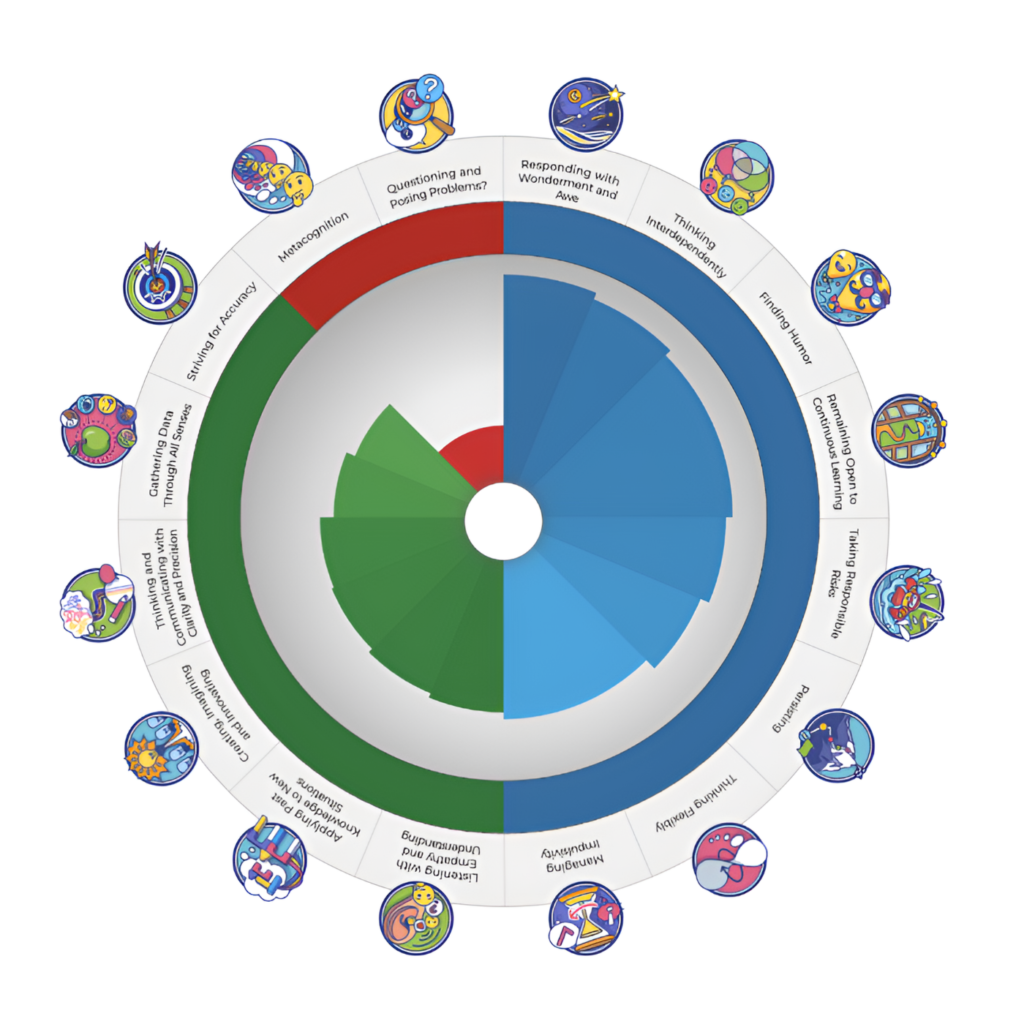We’ve journeyed from understanding how Habits develop, through designing challenges, to enabling student ownership. But there’s been a question lurking beneath it all: How do we know—really know—where each student needs to grow? How can we make invisible development visible?
Sarah Chen stared at her laptop screen, mesmerized. After working to develop her students’ Habits of Mind, she’d finally found what she’d been missing—a way to see exactly where each student stood.
“Look at this,” she called to Michael, who was grading papers at the next desk. “Remember Sophie? The one who kept defaulting to persistence?”
Michael walked over and saw a circular profile on Sarah’s screen—a visual map with 16 segments, each representing a Habit of Mind, colored in orange, blue, green, and red zones.
“Is that—?”
“The Habits of Mind Learner Profile,” Sarah nodded. “It took Sophie about eight minutes to complete. But look what it reveals.”
The Map That Changes Everything
The Learner Profile isn’t just another assessment. It’s a visual diagnostic that shows exactly where students are operating for each Habit of Mind—not in absolute terms, but relative to the problems they regularly face.
Here’s what makes it revolutionary: traditional assessments ask “How well developed are your Habits of Mind?”
The Learner Profile asks “Are your Habits well enough developed for the problems you regularly encounter?”
Think about that difference. A Year 3 student and a Year 12 student might both show green zones for persistence—not because they’re at the same level, but because they’re both appropriately challenged relative to their current circumstances.
The Profile doesn’t measure your standard; it measures whether you’re positioned for growth.
Sophie could be top of her class or struggling—the Profile doesn’t tell us that. What it reveals is far more important: Is she facing challenges that will help her grow?

Each color tells a story:
- Orange (Comfort Zone): Cruising without growth
- Blue (Performance Zone): Working hard but not developing
- Green (Learning Zone): The sweet spot where growth happens
- Red (Aspirational Zone): Overwhelmed and unable to engage
“I always thought Sophie was strong at persistence,” Sarah reflected. “But look—it’s in her blue zone. She’s working hard but using the same strategies she’s always used. No wonder she wasn’t growing.”
Reading the Shapes of Growth
Michael pulled up his class results. “Wait, look at Jake’s profile versus Emma’s. Completely different shapes.”
They were looking at what the analysis guide calls profile shapes—patterns that reveal how students approach challenges:
The Stepped Profile
Jake’s profile showed dramatic steps—some Habits highly developed, others barely touched.
“Classic vulnerability hiding,” Michael observed. “He’s specialized in a few superpowers and avoided the rest. Look at that cliff between his persistence and his flexible thinking.”

This stepped pattern screams vulnerability. When Jake faces problems requiring his weak Habits, he’s defenceless.
The Spiral Profile
Emma’s profile showed a gradual spiral from stronger to weaker Habits.
“At least there’s balance,” Sarah noted. “No sudden drops. She can handle a variety of problems, just at different levels.”

The spiral’s steepness matters. A gentle spiral crossing three zones? Manageable. A steep spiral crossing all four? That student faces wildly different experiences depending on the problem type.
The Well-Rounded Profile
Then there was Marcus—nearly even development across all Habits.
“No significant vulnerabilities,” Michael said. “But also… mostly in the blue zone. He’s performing well but not stretching anywhere.”

Sometimes balance masks a lack of challenge. Marcus needed problems that pushed specific Habits into the green zone.
The Revealing Details
“Show me how to dig deeper,” Michael asked.
Sarah clicked on Sophie’s profile. “First, check the overall color pattern. Sophie’s is predominantly blue with some orange. She’s successful but unchallenged. Classic high achiever who’s stopped growing.”
“Now look at specific Habits. Her flexible thinking? Deep orange—she’s cruising. She faces problems requiring flexible thinking, but they’re too easy for her current level. No wonder she always finds a way to default to persistence instead.”

“But here’s what worried me,” Sarah continued. “See this outer ring? That gray space between where her Habits reach and the edge? That’s her ‘room to grow.’ Sophie has about almost no room for most Habits— we need to give her more challenge, push that outer ring out, so she’s got room to grow.”
From Diagnosis to Development
Michael was already planning. “So for Jake with his stepped profile, I need to…”
“Create safety around his weak Habits,” Sarah finished. “Look—his ‘Finding Humor’ is in the red zone. The problems demanding humor are too far beyond him. He needs the challenge level reduced—scaffolded experiences that bring it into green where he can stretch without strain.”
They discovered the Profile doesn’t just diagnose—it prescribes:
- For Orange Zone Habits: Find harder problems
- For Blue Zone Habits: Find different problems
- For Green Zone Habits: Maintain the challenge level and provide support
- For Red Zone Habits: Reduce challenge to hit the sweet spot—stretch, not strain
- The Power of Critical Clusters
“But here’s where it gets really powerful,” Sarah pulled up her science curriculum. “Remember how we talked about critical clusters—the Habits that work together for specific problems?”
She sketched out a typical science investigation:
- Questioning and Problem Posing (to form hypotheses)
- Thinking Flexibly (when experiments don’t go as planned)
- Striving for Accuracy (for precise measurement)
- Thinking About Thinking (to analyze results)
“Now watch what happens when I compare this cluster to Sophie’s profile.”

The mismatch was revealing. Two of the four critical Habits were in Sophie’s red zone—she was being asked to use superpowers that were beyond her current development relative to the challenge level.
“No wonder she struggled with investigations,” Michael said. “The problems are demanding Habits that are too far beyond where she is right now.”
This opened up new possibilities:
Pre-Challenge Planning: Before setting a complex challenge, identify its critical cluster. Compare it to student profiles. Who will thrive? Who needs support? Who might need a modified version?
Subject-Specific Insights: Different subjects demand different clusters. By mapping these against student profiles, teachers can predict where students might struggle—not because they lack ability, but because they haven’t yet developed the required superpowers.
Targeted Support: Instead of generic help, teachers can now say: “This challenge particularly requires flexible thinking and questioning. Let’s work on some strategies for those before you dive in.”
Beyond the Classroom
“You know what else?” Sarah’s eyes lit up. “Parents would love this.”
She was right. Imagine a parent-teacher conference where instead of vague comments like “needs to try harder,” you could show:
“Here’s Emma’s profile. See this green zone for persistence? She’s growing beautifully there. But notice her orange zone for ‘Applying Past Knowledge’? She’s not getting problems at home or school that help her connect new learning to what she already knows. Here’s how you could help…”
The Profile even allows parent input—they can contribute their observations about how their child handles challenges at home, creating a richer, more complete picture.
Michael started brainstorming: “We could use this for:
- Grouping students with complementary profiles for projects
- Designing differentiated challenges based on zone patterns
- Tracking growth over terms—imagine showing students their profile evolution
- Having students analyze fictional characters’ profiles in literature
- Career guidance—matching student profiles to the demands of different fields”
“Or,” Sarah added, “students could predict which Habits a challenge will demand, then check their predictions against their experience. They’d get better at recognizing problem types.”
The Conversation That Changes Everything
The next day, Sarah sat with Sophie, looking at her profile together.
“I don’t understand,” Sophie said. “I thought I was good at the Habits of Mind. Look at all this blue.”
“Blue means you’re working hard,” Sarah explained. “But are you growing? Look at your flexible thinking—when was the last time you had to truly think differently?”
Sophie studied her orange zones. “I… I guess I always find a way to turn problems into something I can push through.”
“Exactly. You’ve been avoiding your growth edges. But now we can see them clearly.”
Together, they identified three Habits to focus on—all currently in orange. Sophie would choose challenges specifically designed to push these into the green zone.
“But what if I fail?” Sophie asked.
Sarah pointed to the profile. “Then we’ll know the challenge was in your red zone. We’ll adjust and try again. This map shows us exactly where your Learning Zone is.”
The Pattern Recognition Revolution
Michael started noticing patterns across his students’ individual profiles:
“Look at this,” he showed Sarah. “Almost everyone has ‘Questioning and Problem Posing’ in orange. I’m not giving them problems that demand better questions.”
By reviewing multiple profiles, the pattern became clear. His carefully designed challenges developed some Habits while completely ignoring others.
“Time to redesign,” he muttered, already planning challenges that would demand the overlooked superpowers.
Making the Invisible Visible
What the Learner Profile does is make visible what we’ve been discussing throughout this series:
- Which superpowers are actually growing (green)
- Which are stuck despite hard work (blue)
- Which have stagnated from lack of challenge (orange)
- Which challenges are too far beyond current ability (red)
It transforms vague notions—”Sophie works hard,” “Jake avoids challenges”—into specific, actionable insights.
But here’s what matters most: students can see it too.
When Emma looked at her profile, she didn’t see failure in her orange zones. She saw an opportunity. “So these are the superpowers I haven’t developed yet? Cool. What problems can I tackle to grow them?”
That shift—from seeing weaknesses to hide to seeing growth edges to cultivate—that’s the real power of making growth visible.
Your Monday Morning Questions
The Learner Profile takes 5-10 minutes to complete and transforms how you understand each student’s development. Before you design another challenge, ask:
- Which of my students’ Habits are stuck in orange or blue zones?
- What kinds of problems would push those specific Habits into the green zone?
- Are any students showing stepped profiles that reveal hidden vulnerabilities?
- Is my class profile balanced, or am I overlooking certain Habits?
The free trial gives you everything you need to start—including detailed analysis guides for interpreting results. Your students’ invisible growth patterns are about to become visible.
Because here’s what changes everything:
when students can see exactly where they need to grow, they stop avoiding challenges and start seeking them.
When teachers can see precisely which zones need attention, every challenge becomes targeted rather than generic.
The map reveals the territory. Now you can navigate with precision.
Coming Next: Your complete toolkit—now that you know exactly where each student needs to grow, here are the templates, rubrics, and protocols to make it happen.
Ready to see your students’ invisible growth patterns? Start your free trial of the Habits of Mind Learner Profile at www.learnerprofile.app


